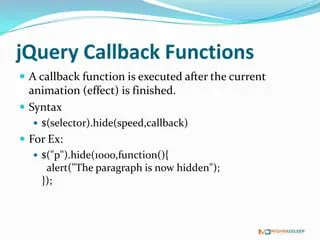Callback functions in jQuery are a fundamental concept that allows you to execute code after a specific event or action has occurred. They are essential for handling asynchronous operations, such as animations, AJAX requests, and user interactions. In this article, we will explore what callback functions are, how to use them in jQuery, and some common use cases.
Understanding Callback Functions
A callback function is a function that you pass as an argument to another function, which will then call it at the appropriate time. The primary purpose of callback functions is to ensure that certain code is executed after a specific operation or event has been completed. This is particularly useful for handling asynchronous tasks, where the exact timing of when a task will finish cannot be predicted.
In jQuery, many functions support callback functions, and these functions are often part of event handling, animation, and AJAX operations. You can use callback functions to define what should happen after an event or operation is completed, without blocking the execution of other code.
Using Callback Functions in jQuery
To use callback functions in jQuery, you need to provide a function as an argument when invoking a jQuery method. jQuery will call this function once the associated operation or event has finished. Here's a basic example:
// Simple example of a callback function
$("button").click(function () {
alert("Button clicked!");
});
In the code above, when a <button> element is clicked, jQuery calls the function provided as a callback, and it displays an alert.
Common Use Cases for Callback Functions
- Animation: Callback functions are often used with animation methods like
fadeIn,fadeOut,slideUp, andslideDown. You can specify what should happen after the animation is complete.
$("#myElement").fadeOut(1000, function() {
// Callback function called after the fadeOut is complete
alert("Element has faded out!");
});
- AJAX: Callback functions are crucial for handling AJAX requests. You can define what should happen when data is successfully retrieved from a server or when an error occurs.
$.ajax({
url: "https://example.com/data",
success: function(data) {
// Callback function for a successful AJAX request
console.log(data);
},
error: function(xhr, status, error) {
// Callback function for an unsuccessful AJAX request
console.log("Error: " + error);
}
});
- Event Handling: Callback functions can respond to user interactions, such as button clicks, form submissions, or keypress events.
$("#myButton").click(function() {
// Callback function for a button click event
alert("Button clicked!");
});
Chaining Callbacks
In jQuery, you can chain multiple callback functions together. This allows you to specify a sequence of actions to be executed one after the other.
$("#myElement")
.fadeOut(1000)
.delay(500)
.fadeIn(1000, function() {
alert("Element has faded out, waited, and faded in.");
});
Conclusion
Callback functions in jQuery are powerful for handling asynchronous tasks, event handling, and animation. They allow you to define what should happen after an operation is complete, ensuring your code remains responsive and efficient. You can create more dynamic and interactive web applications with jQuery by mastering callback functions.
https://www.facebook.com/APSingh007




.jpg)




2 Comments
very good explanation
ReplyDeleteGreat article!
ReplyDelete